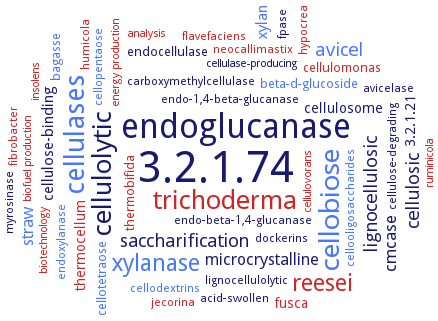3.2.1.74: glucan 1,4-beta-glucosidase
This is an abbreviated version!
For detailed information about glucan 1,4-beta-glucosidase, go to the full flat file.

Word Map on EC 3.2.1.74 
-
3.2.1.74
-
endoglucanase
-
cellulases
-
cellobiose
-
trichoderma
-
cellulolytic
-
reesei
-
xylanase
-
avicel
-
lignocellulosic
-
cellulosic
-
saccharification
-
cmcase
-
microcrystalline
-
straw
-
cellulose-binding
-
xylan
-
3.2.1.21
-
cellulosome
-
fusca
-
thermocellum
-
cellotetraose
-
beta-d-glucoside
-
thermobifida
-
cellulomonas
-
endocellulase
-
bagasse
-
cellulose-degrading
-
cellopentaose
-
hypocrea
-
jecorina
-
acid-swollen
-
cellodextrins
-
fibrobacter
-
endo-beta-1,4-glucanase
-
endoxylanase
-
avicelase
-
myrosinase
-
fpase
-
carboxymethylcellulase
-
neocallimastix
-
endo-1,4-beta-glucanase
-
lignocellulolytic
-
cellooligosaccharides
-
flavefaciens
-
dockerins
-
humicola
-
biofuel production
-
biotechnology
-
cellulase-producing
-
ruminicola
-
insolens
-
analysis
-
energy production
-
cellulovorans
- 3.2.1.74
- endoglucanase
- cellulases
- cellobiose
- trichoderma
-
cellulolytic
- reesei
- xylanase
- avicel
-
lignocellulosic
-
cellulosic
-
saccharification
- cmcase
-
microcrystalline
- straw
-
cellulose-binding
- xylan
-
3.2.1.21
- cellulosome
- fusca
- thermocellum
- cellotetraose
- beta-d-glucoside
- thermobifida
- cellulomonas
- endocellulase
- bagasse
-
cellulose-degrading
- cellopentaose
- hypocrea
- jecorina
-
acid-swollen
- cellodextrins
- fibrobacter
- endo-beta-1,4-glucanase
- endoxylanase
- avicelase
- myrosinase
-
fpase
- carboxymethylcellulase
- neocallimastix
- endo-1,4-beta-glucanase
-
lignocellulolytic
- cellooligosaccharides
- flavefaciens
-
dockerins
- humicola
- biofuel production
- biotechnology
-
cellulase-producing
- ruminicola
- insolens
- analysis
- energy production
- cellulovorans
Reaction
Synonyms
1,4-beta-D-glucan glucanohydrolase, 1,4-beta-D-glucan glucohydrolase, b-glucan glucohydrolase, beta-(1-4)-glucanase, beta-1,4-beta-glucanase, beta-1,4-glucosidase, beta-glucosidase, beta-glucosidase/xylosidase, Bgl, BglA, Carboxymethyl cellulase, CbhA, Cel48A, Cel9A, Cel9D, cellobiase, cellobiohydrolase, Cellulase, Cex, endo-1,4-beta-D-glucanase, endo/exocellulase, Ex-1, exo-1,4-beta-glucanase, exo-1,4-beta-glucosidase, exo-beta-1,4-glucanase, exo-beta-1,4-glucosidase, exo-bets-1,4-glucanase, exocellulase, exocellulase I, exoglucanase, family 9 glycoside hydrolase, family-1 glycosyl hydrolase, FiG, GH9, glucan 1,4-beta-glucosidase, glucohydrolase, NA23_08975, P-42, Rubg3A, Rubg3B, Rucel5B, TSC, Xyn10E


 results (
results ( results (
results ( top
top





